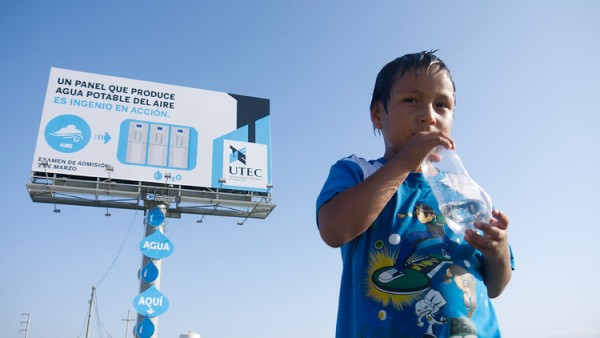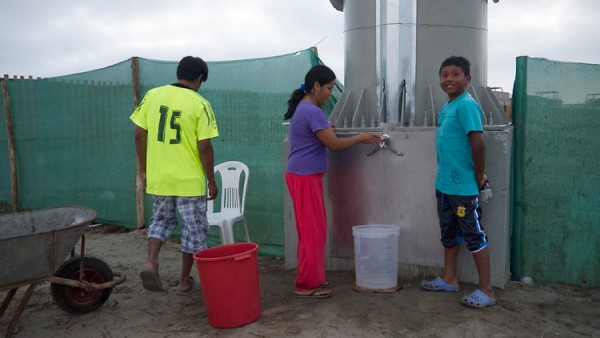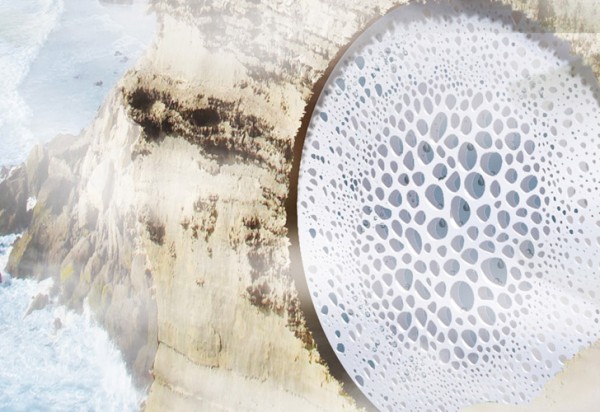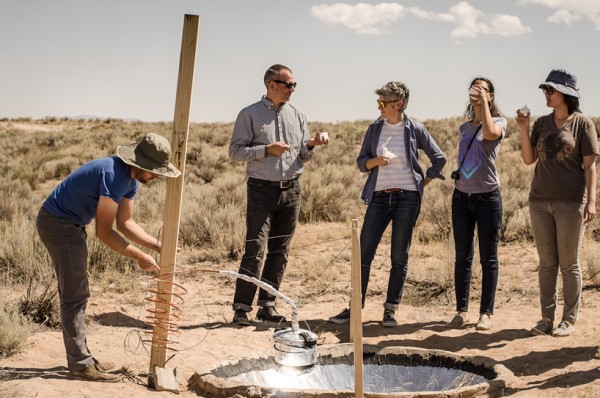For human civilization to survive, people must have access to the three basics: Food, water and shelter. Advanced building materials have evolved over millennia to take care of the shelter part. In recent years, however, new breakthroughs in materials science have made it possible for our shelter materials to provide a limited amount of clean drinking water as well.
Here are three new applications — one conceptual, one an art project and one already in place — that demonstrate the potential for buildings of the future to pull water literally out of thin air, proving that, even in a desert community, life-giving moisture can be found in unexpected places.
Drinking Water Billboard — Lima, Perú

Perú’s capital city, Lima, is on the edge of the Pacific Ocean, which keeps the coastal air sopping wet, with 90 percent relative humidity for most of the year. Yet, due to a quirk of geography, the 8.5 million residents of Lima are located within one of the driest regions on Earth, receiving less than an inch of rain each year. Groundwater sources are overtapped and critically low, so some engineers at the University of Engineering and Technology (UTEC) have worked on some clever ways to convert the moist air into drinking water.

Their demonstration project, oddly enough, is a conventional highway advertising billboard. UTEC researchers, working with ad agency and billboard owner, Mayo DraftFCB, installed a condenser, a reverse osmosis filter, an activated-carbon filter and storage tanks to pull moisture out of the air as it flows past the board.
In its first three months, the billboard produced roughly 2,600 gallons of clean, drinkable water, which is accessible for the people of Lima’s Bujama District via a spigot at the base of the tower. UTEC hopes the project can be replicated in dozens of other sites in the region where water is scarce. The blight of corporate advertising has never looked so attractive.
Mist Tree Tower Concept—Atacama Desert, Chile

Taking the Lima idea to a much larger scale, American architecture students Yeonkyu Park, Kwon Han, Hyeyeon Kwon, and Hojeong Lim submitted a proposal to bring coastal fog from the west coast of Chile and drawing it through a mountain chain to inland regions of the parched Atacama Desert.

Their Mist Tree Tower design, which won an honorable mention in this year’s eVolo Skyscraper Competition, include a series of giant circular mesh openings embedded in the cooler, more humid western side of the Andes Mountains. The mesh would capture the “Camanchaca,” the local name for the thick fog than hangs along the Pacific Coast but is blocked by the mountains.
The complex surface area of the mesh on the building’s façade would act like the cross-section of a tree root, only pulling water from the air rather than the ground. The mesh gathers condensation, much the way a spider web attracts dew drops, but on a massive scale. Glazed openings in the mesh would also capture solar energy that would heat the interior and encourage more water condensation. Once collected, the water flows by gravity through underground channels to nourish trees and plants on the arid eastern side.
Cloud Vessels Project—Los Lunas, N.M.

Another promising application is based on ancient water-harvesting techniques and has been given an artistic flourish by New York City-based artist Nova Jiang. Seeking a way to serve drinking water gathered from the air for an art project, Jiang collaborated with fellow artist Jamie O’Shea,who had been working on a simple solar furnace he calls “The Caloris Basin,” located in the desert regions of New Mexico.

Together, they created a water generator based on long-known absorptive properties of anhydrous calcium chloride, the dessicant that is often included in small packets to protect electronics during shipment. First, the salt crystals are laid out on the ground at night to absorb the moisture in the air; even air with humidity as low as 10 percent will produce enough moisture to saturate the crystals.
Then, during the day, the salt crystals are collected and added to a chamber within the Caloris Basin, which is a hemisphere cut into the ground, measuring a few feet across, and lined with a thin mirrored surface. As the sun rises, the rays are collected and concentrated by the concave basin, heating up the vessel to the boiling point and distilling fresh drinking water that had once been in the air. The salts left behind can then be used indefinitely to restart the process each evening.

For this demonstration, Jiang also created small cloud-shaped vessels using 3D imaging software and then printed them out with a 3D printer, using food-grade ceramics as the medium. Then she had a local glassblower recreate the shapes using glass. The final glass clouds were then used for a series of water-tasting parties hosted by Jiang, who showed her guests the entire process.
According to O’Shea, the process could be scaled up to provide cost-effective drinking water in some desert communities. The moisture could be captured in a liquid brine mixture that could be heated when necessary in a series of easy-to-build Caloris Basins.